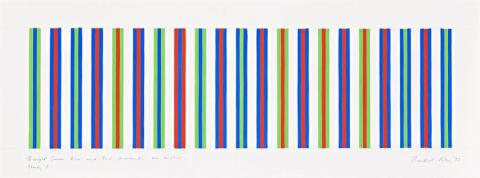BRIGHT GREEN, BLUE AND RED, SURROUNDING ONE ANOTHER, STUDY 3, 1973
BRIDGET RILEY
gouache on paper
30.0 x 82.0 cm
signed and dated lower right: Bridget Riley '73
inscribed lower left: Bright Green, Blue and Red, surrounding one another / Study 3
inscribed verso: R1203
Collection of Lex Aitken and Alfredo (Bouret) Gonzalez, Sydney, acquired directly from the artist, c1973
Sequence Study: Bright Green, Blue and Red, 1973, gouache on paper, 30.5 x 167.5 cm, collection of the artist, illus. in Moorhouse, P. (ed.), Bridget Riley, Tate Publishing, London, 2003, cat. 75, pp. 118–119
'I saw that the basis of colour is its instability. Instead of searching for a firm foundation, I realised I had one in the very opposite. That was solid ground again, so to speak, and by accepting this paradox I could begin to work with the fleeting, the elusive - and so a whole new area of activity, of perception opened up for me.'1
Where previously Riley's adoption of a monochrome palette had enabled her to investigate the cyclic movement of repose and disturbance, no such stable basis existed for colour, as she had long been aware from her immersion in the art of Seurat. Indeed, with the perception of colour inherently unstable, Riley recognised that the experience of colour was entirely relative - its behaviour and appearance dependent upon context. Accordingly, in 1967 when she first commenced her explorations in colour, the emphasis upon highlighting the presence of 'perception' in her art receded with Riley pursuing rather the interaction of colours and their potential to convey a powerful impression of light. Strongly reminiscent of the monumental Paean, 1973 (National Museum of Modern Art, Tokyo) executed the same year in a similarly restricted palette of intense, highly saturated reds, blues and greens woven together in narrow vertical bands of equal width, the present compositions (lots 5-9) encapsulate well this transition in the artist's intentions. With the colours of each repeated triad inflected slightly and interspersed between white ground to create a dynamic surface play of vivid flickering light, the objective is now a more subtle 'continuous instability', a gentle inevitability as opposed to the arresting formal destabilisation of her black-and-white oeuvre.
1. Riley, cited in Kudielka, R., (ed.), Bridget Riley: Dialogues on Art, Zwemmer, London, and Wappingers' Falls, New York, 1995, p. 56
VERONICA ANGELATOS
